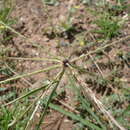Physical Description
provided by USDA PLANTS text
Perennials, Terrestrial, not aquatic, Stolons or runners present, Stems nodes swollen or brittle, Stems erect or ascending, Stems caespitose, tufted, or clustered, Stems terete, round in cross section, or polygonal, Stem internodes solid or spongy, Stem internodes hollow, Stems with inflorescence less than 1 m tall, Stems, culms, or scapes exceeding basal leaves, Leaves mostly cauline, Leaves conspicuously 2-ranked, distichous, Leaves sheathing at base, Leaf sheath mostly open, or loose, Leaf sheath smooth, glabrous, Leaf sheath or blade keeled, Leaf sheath and blade differentiated, Leaf blades linear, Leaf blades 2-10 mm wide, Leaf blades mostly flat, Leaf blades mostly glabrous, Leaf blades scabrous, roughened, or wrinkled, Ligule present, Ligule a fringed, ciliate, or lobed membrane, Inflorescence terminal, Inflorescence solitary, with 1 spike, fascicle, glomerule, head, or cluster per stem or culm, Inflorescence a panicle with narrowly racemose or spicate branches, Inflorescence a panicle with digitately arranged spicate branches, Inflorescence with 2-10 branches, Inflorescence branches more than 10 to numerous, Inflorescence branches 1-sided, Lower panicle branches whorled, Inflorescence branches paired or digitate at a single node, Flowers bisexual, Spikelets sessile or subsessile, Spikelets laterally compressed, Spikelet less than 3 mm wide, Spikelets with 1 fertile floret, Spikelets with 2 florets, Spikelets solitary at rachis nodes, Spikelets all alike and fertille, Spikelets bisexual, Spikelets disarticulating above the glumes, glumes persistent, Spikelets disarticulating beneath or between the florets, Rachilla or p edicel glabrous, Glumes present, empty bracts, Glumes 2 clearly present, Glumes distinctly unequal, Glumes shorter than adjacent lemma, Glumes keeled or winged, Glumes 1 nerved, Lemma similar in texture to glumes, Lemma 3 nerved, Lemma body or surface hairy, Lemma apex truncate, rounded, or obtuse, Lemma apex dentate, 2-fid, Lemma distinctly awned, more than 2-3 mm, Lemma with 1 awn, Lemma awn less than 1 cm long, Lemma awn 1-2 cm long, Lemma awn subapical or dorsal, Lemma awns straight or curved to base, Lemma margins thin, lying flat, Lemma straight, Callus or base of lemma evidently hairy, Callus hairs shorter than lemma, Palea present, well developed, Palea shorter than lemma, Palea 2 nerved or 2 keeled, Stamens 3, Styles 2-fid, deeply 2-branched, Stigmas 2, Fruit - caryopsis, Caryopsis ellipsoid, longitudinally grooved, hilum long-linear.
Chloris truncata: Brief Summary
provided by wikipedia EN
Chloris truncata, known by the common names Australian fingergrass, windmill-grass, Australian windmill grass and simply windmill grass locally in Australia, is a perennial grass.
Chloris truncata is a low-growing grass forming a small clump of around 30 centimetres in diameter. It has long leaves, approximately 10–15 cm long with a distinctive blunt tip and flattened leaf sheath at the base. It is light green in colour with a prominent central vein.
The plant gets its common name from its large windmill-shaped flowering heads, which can be around 30 cm across. Each of the long black spikes is lined with black seeds which have two awns each. Seed is set in both summer and winter. The plant spreads moderately fast, but is relatively hard to propagate. It prefers full sun and may be used as a lawn grass if mowed lightly.
- license
- cc-by-sa-3.0
- copyright
- Wikipedia authors and editors

